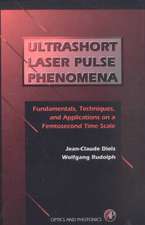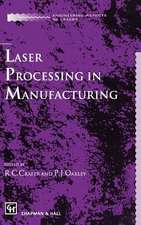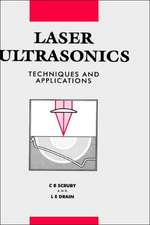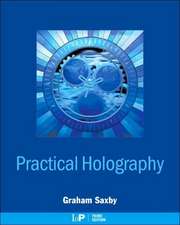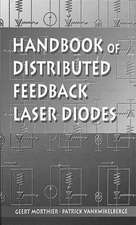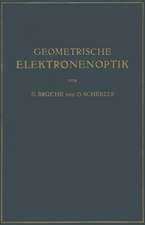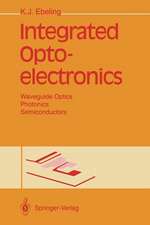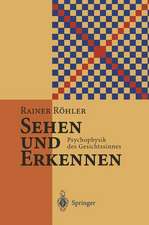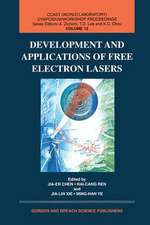X-Ray Diffraction Imaging of Biological Cells: Springer Series in Optical Sciences, cartea 210
Autor Masayoshi Nakasakoen Limba Engleză Hardback – 12 apr 2018
To conduct CXDI experiments in both synchrotron and XFEL facilities, the author has developed apparatuses, named KOTOBUKI-1 and TAKASAGO-6 for cryogenic diffraction experiments on frozen-hydrated non-crystalline particles at around 66 K. At the synchrotron facility, cryogenic diffraction experiments dramatically reduce radiation damage of specimen particles and allow tomography CXDI experiments. In addition, in XFEL experiments, non-crystalline particles scattered on thin support membranes and flash-cooled can be used to efficiently increase the rate of XFEL pulses. The rate, which depends on the number density of scattered particles and the size of X-ray beams, is currently 20-90%, probably the world record in XFEL-CXDI experiments. The experiment setups and results are introduced in this book. The author has also developed software suitable for efficiently processing of diffraction patterns and retrieving electron density maps of specimen particles based on the diffraction theory used in CXDI.
| Toate formatele și edițiile | Preț | Express |
|---|---|---|
| Paperback (1) | 1105.68 lei 6-8 săpt. | |
| Springer – 10 ian 2019 | 1105.68 lei 6-8 săpt. | |
| Hardback (1) | 1111.67 lei 6-8 săpt. | |
| Springer – 12 apr 2018 | 1111.67 lei 6-8 săpt. |
Din seria Springer Series in Optical Sciences
- 24%
 Preț: 945.45 lei
Preț: 945.45 lei - 18%
 Preț: 1850.21 lei
Preț: 1850.21 lei - 18%
 Preț: 2124.06 lei
Preț: 2124.06 lei - 20%
 Preț: 568.46 lei
Preț: 568.46 lei - 18%
 Preț: 1118.93 lei
Preț: 1118.93 lei - 18%
 Preț: 999.76 lei
Preț: 999.76 lei - 18%
 Preț: 957.62 lei
Preț: 957.62 lei - 18%
 Preț: 892.11 lei
Preț: 892.11 lei - 15%
 Preț: 648.56 lei
Preț: 648.56 lei - 18%
 Preț: 1838.07 lei
Preț: 1838.07 lei -
 Preț: 379.86 lei
Preț: 379.86 lei - 18%
 Preț: 1392.95 lei
Preț: 1392.95 lei - 18%
 Preț: 1232.89 lei
Preț: 1232.89 lei - 18%
 Preț: 1568.95 lei
Preț: 1568.95 lei - 18%
 Preț: 2095.49 lei
Preț: 2095.49 lei - 18%
 Preț: 1227.84 lei
Preț: 1227.84 lei - 15%
 Preț: 643.65 lei
Preț: 643.65 lei - 18%
 Preț: 954.45 lei
Preț: 954.45 lei - 18%
 Preț: 947.35 lei
Preț: 947.35 lei - 18%
 Preț: 1241.55 lei
Preț: 1241.55 lei - 18%
 Preț: 947.04 lei
Preț: 947.04 lei -
 Preț: 392.21 lei
Preț: 392.21 lei - 18%
 Preț: 997.53 lei
Preț: 997.53 lei - 18%
 Preț: 1562.31 lei
Preț: 1562.31 lei - 18%
 Preț: 1110.24 lei
Preț: 1110.24 lei - 15%
 Preț: 651.19 lei
Preț: 651.19 lei -
 Preț: 414.69 lei
Preț: 414.69 lei - 18%
 Preț: 952.57 lei
Preț: 952.57 lei - 15%
 Preț: 641.03 lei
Preț: 641.03 lei - 15%
 Preț: 635.80 lei
Preț: 635.80 lei
Preț: 1111.67 lei
Preț vechi: 1355.69 lei
-18% Nou
Puncte Express: 1668
Preț estimativ în valută:
212.72€ • 219.45$ • 177.51£
212.72€ • 219.45$ • 177.51£
Carte tipărită la comandă
Livrare economică 26 martie-09 aprilie
Preluare comenzi: 021 569.72.76
Specificații
ISBN-13: 9784431566168
ISBN-10: 4431566163
Pagini: 170
Ilustrații: XX, 228 p. 96 illus., 89 illus. in color.
Dimensiuni: 155 x 235 x 28 mm
Greutate: 0.53 kg
Ediția:1st ed. 2018
Editura: Springer
Colecția Springer
Seria Springer Series in Optical Sciences
Locul publicării:Tokyo, Japan
ISBN-10: 4431566163
Pagini: 170
Ilustrații: XX, 228 p. 96 illus., 89 illus. in color.
Dimensiuni: 155 x 235 x 28 mm
Greutate: 0.53 kg
Ediția:1st ed. 2018
Editura: Springer
Colecția Springer
Seria Springer Series in Optical Sciences
Locul publicării:Tokyo, Japan
Cuprins
Introduction.- X-ray diffraction.- Theory of X-ray diffraction imaging.- Diffraction apparatus for X-ray diffraction imaging.- Specimen preparation for X-ray diffraction imaging experiments at cryogenic temperature.- Processing of diffraction patterns obtained from X-ray diffraction imaging experiments using X-ray free electron laser pulses.- Phase retrieval of diffraction patterns.- Projection structures of biological cells and organelles.- Three-dimensional structural analyses in cryogenic X-ray diffraction imaging.- Prospects for the structural analysis of biological specimens by X-ray diffraction imaging.
Notă biografică
Masayoshi Nakasako is a professor at Keio University, whose work chiefly involves the structural analysis of soft matter. After receiving his Doctor of Science from Tohoku University in 1990, he served as a research associate at the University of Tokyo’s Faculty of Pharmaceutical Sciences, as a researcher at RIKEN, as a lecturer at the University of Tokyo’s Institute of molecular and Cellular Biosciences, and as an assistant professor at Keio University in 2002. In 2005, he was promoted to his present position. Currently, he is also a guest researcher at RIKEN’s Spring-8 Center.
His primary research interest is in imaging protein hydration, protein structures, and cells by means of molecular dynamics simulations and various physicochemical experimental techniques including X-ray imaging using synchrotron radiation and X-ray free electron lasers.
His primary research interest is in imaging protein hydration, protein structures, and cells by means of molecular dynamics simulations and various physicochemical experimental techniques including X-ray imaging using synchrotron radiation and X-ray free electron lasers.
Textul de pe ultima copertă
In this book, the author describes the development of the experimental diffraction setup and structural analysis of non-crystalline particles from material science and biology. Recent advances in X-ray free electron laser (XFEL)-coherent X-ray diffraction imaging (CXDI) experiments allow for the structural analysis of non-crystalline particles to a resolution of 7 nm, and to a resolution of 20 nm for biological materials. Now XFEL-CXDI marks the dawn of a new era in structural analys of non-crystalline particles with dimensions larger than 100 nm, which was quite impossible in the 20th century.
To conduct CXDI experiments in both synchrotron and XFEL facilities, the author has developed apparatuses, named KOTOBUKI-1 and TAKASAGO-6 for cryogenic diffraction experiments on frozen-hydrated non-crystalline particles at around 66 K. At the synchrotron facility, cryogenic diffraction experiments dramatically reduce radiation damage of specimen particles and allow tomography CXDI experiments. In addition, in XFEL experiments, non-crystalline particles scattered on thin support membranes and flash-cooled can be used to efficiently increase the rate of XFEL pulses. The rate, which depends on the number density of scattered particles and the size of X-ray beams, is currently 20-90%, probably the world record in XFEL-CXDI experiments. The experiment setups and results are introduced in this book. The author has also developed software suitable for efficiently processing of diffraction patterns and retrieving electron density maps of specimen particles based on the diffraction theory used in CXDI.
To conduct CXDI experiments in both synchrotron and XFEL facilities, the author has developed apparatuses, named KOTOBUKI-1 and TAKASAGO-6 for cryogenic diffraction experiments on frozen-hydrated non-crystalline particles at around 66 K. At the synchrotron facility, cryogenic diffraction experiments dramatically reduce radiation damage of specimen particles and allow tomography CXDI experiments. In addition, in XFEL experiments, non-crystalline particles scattered on thin support membranes and flash-cooled can be used to efficiently increase the rate of XFEL pulses. The rate, which depends on the number density of scattered particles and the size of X-ray beams, is currently 20-90%, probably the world record in XFEL-CXDI experiments. The experiment setups and results are introduced in this book. The author has also developed software suitable for efficiently processing of diffraction patterns and retrieving electron density maps of specimen particles based on the diffraction theory used in CXDI.
Caracteristici
Provides the first book on coherent X-ray diffraction imaging technique using the X-ray free electron laser SACLA in Japan written by a leader in the field Introduces the history, theory and computational simulation regarding of coherent X-ray diffraction imaging Describes experimental setups developed by the author, as well as modelling software to analyze the data

